History
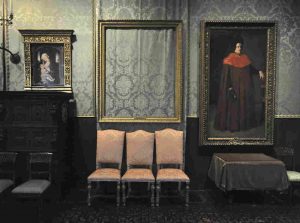 If you watch cop shows at all, you will know that if they are right, most crimes are solved…and in short order too. Of course, most of us realize that isn’t exactly the case. While I like to think most crimes are solved, there are still a great number of them that take years to solve and sometimes they remain unsolved indefinitely, if not forever. I suppose those would be the perfect crimes, but it is sad to think that a criminal gets away with a crime, no matter what it is. Such appears to be the case in the March 18, 1990 theft of 13 masterpieces worth $500 million from Boston’s Isabella Stewart Gardner Museum. The theft took place 26 years ago, and has never been solved, and the pieces are still missing.
If you watch cop shows at all, you will know that if they are right, most crimes are solved…and in short order too. Of course, most of us realize that isn’t exactly the case. While I like to think most crimes are solved, there are still a great number of them that take years to solve and sometimes they remain unsolved indefinitely, if not forever. I suppose those would be the perfect crimes, but it is sad to think that a criminal gets away with a crime, no matter what it is. Such appears to be the case in the March 18, 1990 theft of 13 masterpieces worth $500 million from Boston’s Isabella Stewart Gardner Museum. The theft took place 26 years ago, and has never been solved, and the pieces are still missing.
The museum was closed, and the night watchman, Richard Abath was on duty. Boston’s Saint Patrick’s Day revelers were finishing their last drinks before going home to sleep it off. Two police officers showed up at the door of the museum and rang the buzzer at 1:24 am. When the watchman opened the door, they informed him that they were there about the disturbance. The night watchman had been trained to first call Boston police headquarters to confirm officers’ names and badge numbers, but 23 year old Abath, who was an aspiring rock musician, and had given his notice days earlier, pressed a button to let the pair inside. The uniformed men ordered Abath to summon his fellow guard, 25 year old Randy Hestand, to the lobby.
When one of the officers said that Abath looked like someone they had a warrant out on, he broke protocol a second time when he left the desk, where the only panic button was, and obeyed their command to show them some identification. They handcuffed him and the arriving Hestand, who was filling in for a sick colleague and working the night shift for the first time. When both men were handcuffed, the men in police uniforms informed the guards, “This is a robbery, gentlemen.” Using duct tape, the intruders wrapped the guards like mummies, even covering Abath’s shoulder length curly hair and left them in the basement where they handcuffed Hestand to a sink and Abath to a workbench 40 yards away.
Then the thieves ransacked the museum, which had been a gift to the people of Boston in 1903, given by philanthropist, Isabella Stewart Gardner. Had they gone in and strategically taken valuable items, the robbery might have made sense, I suppose, but while they took $500 million worth of art, they also destroyed so much. They smashed gilded painting frames onto marble floors and sliced canvasses from their wooden backings. The robbers left an empty frame on the office chair of the museum’s security director and removed the recording tape from security system’s camera before departing 81 minutes after their arrival in a dark colored hatchback that disappeared into the night.
The two night watchmen were found the next morning, but the 13 pieces of artwork worth $500 million were gone. The most expensive piece was a painting titled “The Concert,” by Johannes Vermeer…one of only 36 known paintings by the Dutch master. The robbers got away with a sketch and two paintings by Rembrandt, including his only known seascape, “Storm on the Sea of Galilee.” They also took a Govaert Flinck landscape, Edouard Manet’s “Chez Tortoni,” five watercolors and sketches by Edgar Degas, a finial eagle that sat atop a Napoleonic flag that the thieves could not unscrew from the wall and an ancient Chinese vase. Strangely, the robbers had left untouched the museum’s most valuable painting, Titian’s “The Rape of Europa,” but an unwound coat hanger found near the candy machine suggested that they had also taken chocolate bars. It is suspected that the 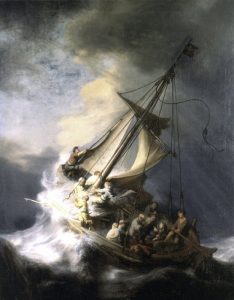 men were working off of a specific list of items contracted for in advance by a black market collector outside of the United States. Latin American drug cartels, Irish Republican Army militants and even Vatican operatives were floated as suspects. Suspicion also fell on notorious Boston mobster James “Whitey” Bulger, but he was searching for whomever committed the audacious crime on his home “turf” as well so that he could exact a cut. The FBI investigation into Abath, who was the only person tracked by motion sensors in the gallery from which the Manet was swiped, did not yield any answers.
men were working off of a specific list of items contracted for in advance by a black market collector outside of the United States. Latin American drug cartels, Irish Republican Army militants and even Vatican operatives were floated as suspects. Suspicion also fell on notorious Boston mobster James “Whitey” Bulger, but he was searching for whomever committed the audacious crime on his home “turf” as well so that he could exact a cut. The FBI investigation into Abath, who was the only person tracked by motion sensors in the gallery from which the Manet was swiped, did not yield any answers.
The case has grown cold, and unless some kind of new clues surface, it will likely remain unsolved. The frames that held the stolen paintings remain empty to this day, and still hang in the Isabella Stewart Gardner Museum, in the same places they were then…waiting for their lost painting to hopefully be returned someday. Time will tell.
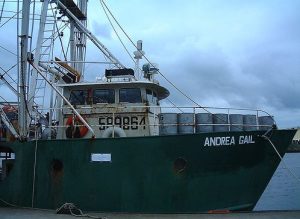
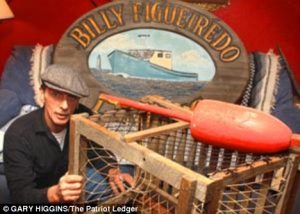 After the movie, The Perfect Storm came out, swordfishing boat, Andrea Gail became almost a household name. We could relate to the feelings of loss the families of those men felt, and found it hard to get past the idea of how those men died. Those things are a normal reaction to such a tragedy, but in the end, we expected they would find the swordfishing boat, and be able to bring closure to the families…allowing them to bury their dead. Sometimes, however, a lost ship takes a long time to find, and strangely, sometimes it is never found at all. Such was the case with the Andrea Gail. Her last coordinates had been called out on the emergency radio, but this was such a fierce storm, and the Andrea Gail was right in the middle of it, trying desperately to make it back home.
After the movie, The Perfect Storm came out, swordfishing boat, Andrea Gail became almost a household name. We could relate to the feelings of loss the families of those men felt, and found it hard to get past the idea of how those men died. Those things are a normal reaction to such a tragedy, but in the end, we expected they would find the swordfishing boat, and be able to bring closure to the families…allowing them to bury their dead. Sometimes, however, a lost ship takes a long time to find, and strangely, sometimes it is never found at all. Such was the case with the Andrea Gail. Her last coordinates had been called out on the emergency radio, but this was such a fierce storm, and the Andrea Gail was right in the middle of it, trying desperately to make it back home.
The name Perfect Storm depicted not just another storm or even just another hurricane…this storm was a monster. The 1991 Perfect Storm, also known as the The No-Name Storm, especially in the years immediately after it took place, and the Halloween Gale, was a nor’easter that absorbed Hurricane Grace and ultimately evolved back into a small unnamed hurricane late in its life cycle. The area of low pressure developed off Atlantic Canada on October 29. A ridge of high pressure to its north pushed it southward. Then, it reached its peak intensity as a large and powerful cyclone. The storm battered the east coast of the United States with high waves and coastal flooding before it turned southwest and weakened. Moving over warmer waters, it transitioned into a subtropical cyclone before becoming a tropical storm. It made a loop off the Mid-Atlantic states and turned toward the northeast. On November 1 the system evolved into a full-fledged hurricane with peak winds of 75 miles per hour, although the National Hurricane Center left it unnamed to avoid confusion amid media interest in the predecessor extratropical storm. It later received the name “the Perfect Storm” after a conversation between Boston National Weather Service forecaster Robert Case and author Sebastian Junger. The system was the fourth hurricane and final tropical cyclone in the 1991 Atlantic hurricane season. The tropical system weakened, striking Nova Scotia as a tropical storm before dissipating. There were thirteen confirmed deaths from the storm, including six on board Andrea Gail.
Everyone who saw the movie, now also knows about the Flemish Cap, which is an area of the Atlantic Ocean off the coast of Nova Scotia, and was where the Andrea Gail was when The Perfect Storm began its rampage. The Andrea Gail had sailed from Gloucester, Massachusetts on September 20, 1991, and after a minimal catch, sailed for the Flemish Cap. After encountering high seas in the middle of the storm, the vessel made its last radio contact late on October 28 about 180 miles northeast of Sable Island. After that, they tried to make a run for it through the storm, rather than lose their catch to spoil. The Andrea Gail sank while returning to Gloucester. Over the next few days, only three pieces of debris were found, and the Coast Guard said those could have washed off the boat in rough seas. To date, the boat, and her crew, David Sullivan, Robert Shatford, William Tyne, Dale Murphy, Michael Moran, and Alfred Pierre, have never been found.
However…on December 2, 2011 the Daily Mail Reporter printed this story…Lobster pot tag washes up 3,000 miles away across the Atlantic…two decades after being lost in Perfect Storm that inspired film. “A tag from a lobster pot lost two decades ago in what came to be known as ‘The Perfect Storm’ has washed up 3,000 miles away in Ireland. The pot that held the tag with Richard Figueiredo’s name on it was one of hundreds he lost when the storm struck off Cohasset, Massachusetts, in 1991. Rosemary Hill, of Waterville, County Kerry, found the tag on a beach last year. Last week she decided to try to contact Mr Figueiredo and found him through the Facebook account of his son Rich. Oceanographer Curt Ebbesmeyer told The Patriot Ledger newspaper that the tag’s 20-year drift is unusually long. Mr Ebbesmeyer, who studies flotsam and ocean currents, said the pot and tag may have been buried in offshore mud before drifting south off the U.S. Atlantic coast and then getting caught the in eastward Gulf Stream. He added that the tag then probably drifted south again into the circular Subtropical Gyre current in the mid-Atlantic, making six three-year loops before it again caught the Gulf Stream toward Ireland. Coast to coast: The tag would have made several loops as it drifted with a leading oceanographer saying it may have clocked up 50,000 miles. He believes in total it could have drifted 50,000 miles. Miss Hill, 39, loves beachcombing and said that this is the first time she’s ever traced a buoy or other piece of maritime flotsam to its owner. She told The Patriot Ledger she saw the orange tag amid clumps of seaweed on a stroll last year. She added it to other beach souvenirs and then forgot about it until last week. ‘I 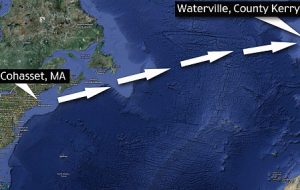
 looked at it again and thought, “Why not try to find the owner?”‘ she said. ‘Nothing ventured, nothing gained.’ Mr Figueiredo and Miss Hill spoke last Thursday. She said she would mail the tag to him, but he wants her to keep it. He said: ‘The meaning it has over there is what matters. ‘I am honored that she has put so much enthusiasm into this. What’s happening now is a gift to me.'” I find that to be an absolutely amazing journey.
looked at it again and thought, “Why not try to find the owner?”‘ she said. ‘Nothing ventured, nothing gained.’ Mr Figueiredo and Miss Hill spoke last Thursday. She said she would mail the tag to him, but he wants her to keep it. He said: ‘The meaning it has over there is what matters. ‘I am honored that she has put so much enthusiasm into this. What’s happening now is a gift to me.'” I find that to be an absolutely amazing journey.
 Anytime a nation’s leader is killed, it’s a disaster, no matter how they died, but it is not so common for the disaster to still be felt when their child is killed, although the nation naturally feels a degree of collective sadness. In a monarchy, however, things are different. The child of the current king stands to be the next leader. These days, having a girl be the next in line for the throne is not a problem, in most nations, but that was not the case in England in 1120. At the time, the king of England was King Henry I. The Norman dynasty had not been in power very long, and the King Henry I was very eager to have the line continue on. His problem was solved with the birth of his only legitimate son, William the Aethling, who was called by the Saxon princely title to stress that his parents had united both Saxon and Norman Royal Houses. William was a warrior prince who, even at the age of seventeen, fought alongside his father to reassert their rights in their Norman lands on the Continent. As was common with kings, especially in that era, and maybe not so unusual in this era, the king had multiple concubines, and so several illegitimate children too. He did have a legitimate daughter named Matilda, but the throne belonged to his son. His illegitimate children were Richard, and oddly, a second Matilda. All seemed right in his world.
Anytime a nation’s leader is killed, it’s a disaster, no matter how they died, but it is not so common for the disaster to still be felt when their child is killed, although the nation naturally feels a degree of collective sadness. In a monarchy, however, things are different. The child of the current king stands to be the next leader. These days, having a girl be the next in line for the throne is not a problem, in most nations, but that was not the case in England in 1120. At the time, the king of England was King Henry I. The Norman dynasty had not been in power very long, and the King Henry I was very eager to have the line continue on. His problem was solved with the birth of his only legitimate son, William the Aethling, who was called by the Saxon princely title to stress that his parents had united both Saxon and Norman Royal Houses. William was a warrior prince who, even at the age of seventeen, fought alongside his father to reassert their rights in their Norman lands on the Continent. As was common with kings, especially in that era, and maybe not so unusual in this era, the king had multiple concubines, and so several illegitimate children too. He did have a legitimate daughter named Matilda, but the throne belonged to his son. His illegitimate children were Richard, and oddly, a second Matilda. All seemed right in his world.
King Henry I was king from August 2, 1100, until his death on December 1, 1135, and expected that his son, Prince William would take his place as king upon his death. Then disaster struck on the November 25, 1120. This was a disaster that would have a dramatic effect, not only on the families of those involved, but on the very fabric of English Government. After a successful battle in 1119, which brought the defeat of King Louis IV of France, and the humiliation at the Battle of Brémule, the King and his entourage were headed home to celebrate. The king was offered a fine ship, the White Ship to travel home in, but he declined because he had already made other arrangements. He suggested that his son and some of the other men could talk the journey on the White Ship.
As the heir to the throne, Prince William attracted the cream of society to surround him. His entourage was to include some three hundred fellow passengers…140 knights and 18 noblewomen, his half-brother, Richard, his half-sister, Matilda the Countess of Perche; his cousins, Stephen and Matilda of Blois, the nephew of the German Emperor Henry V, the young Earl of Chester and most of the heirs to the great estates of England and Normandy. The passengers were all in a mood to celebrate, and asked the Prince for drinks. The prince had brought wine aboard the ship by the barrel-load to help with the festivities. Before long the both passengers and crew became highly intoxicated. Some even left the shop when things started getting abusive.
The people who remained were drunk, and decided that it would be a great idea to try to catch the ship the king was on. The king’s ship had already sailed out into the English Channel. 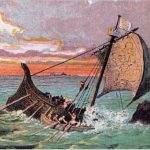 The people kept pushing the captain to accept the challenge. The captain was sure that his ship could catch the king’s ship, so they set out that evening, and immediately struck a rock in the channel as they left. The ship began to sink, and Prince William was safely in a boat, but he heard his half-sister, Matilda screaming for help. So he left the boat to rescue her. The boat he was in was hit by a group of desparate passengers, and swamped. Prince William was lost and drown. The nation was devastated, and when King Henry I tried to get them to accept his legitimate daughter, Matilda, but they didn’t want to and when the king died, Matilda and her husband found themselves fighting for the throne in a war known as The Anarchy.
The people kept pushing the captain to accept the challenge. The captain was sure that his ship could catch the king’s ship, so they set out that evening, and immediately struck a rock in the channel as they left. The ship began to sink, and Prince William was safely in a boat, but he heard his half-sister, Matilda screaming for help. So he left the boat to rescue her. The boat he was in was hit by a group of desparate passengers, and swamped. Prince William was lost and drown. The nation was devastated, and when King Henry I tried to get them to accept his legitimate daughter, Matilda, but they didn’t want to and when the king died, Matilda and her husband found themselves fighting for the throne in a war known as The Anarchy.
 It’s always fun to find out that you are related to someone who is famous, and for me, it has been common knowledge for all of my life. The Spencer side of my family is full of aristocracy. Some are princes and princesses, and even future kings, and others were great strategists, like Winston Leonard Spencer-Churchill, who is my 15th cousin once removed. You will notice the hyphen, and while it isn’t in his name, it is nevertheless, correct. He was a product of grandparents who merged two wealthy family names, when his 4th great grandfather, Charles Spencer married Ann Churchill and they hyphenated the names. Later, family members either used the traditional Spencer name, such as Diana Spencer’s line, or they used the Churchill name, as Winston Churchill’s line did, even though they continued the Spencer part of the name in his line. People have often thought it was his middle name, but that is not so. I don’t know if they used the hyphen back then, but the names were both last names.
It’s always fun to find out that you are related to someone who is famous, and for me, it has been common knowledge for all of my life. The Spencer side of my family is full of aristocracy. Some are princes and princesses, and even future kings, and others were great strategists, like Winston Leonard Spencer-Churchill, who is my 15th cousin once removed. You will notice the hyphen, and while it isn’t in his name, it is nevertheless, correct. He was a product of grandparents who merged two wealthy family names, when his 4th great grandfather, Charles Spencer married Ann Churchill and they hyphenated the names. Later, family members either used the traditional Spencer name, such as Diana Spencer’s line, or they used the Churchill name, as Winston Churchill’s line did, even though they continued the Spencer part of the name in his line. People have often thought it was his middle name, but that is not so. I don’t know if they used the hyphen back then, but the names were both last names.
Churchill was born to Lord Randolph Spencer and his wife Jennie Jerome, on November 30, 1874. They were members of a prestigious family with a long history of military service and upon his father’s death in 1895, 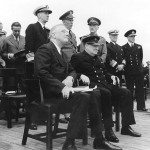 Winston joined the British Fourth Hussars. During the next five years, Winston Churchill enjoyed an illustrious military career, serving in India, the Sudan, and South Africa, and distinguishing himself several times in battle. In 1899, he resigned his commission to concentrate on his literary and political career and in 1900 was elected to Parliament as a Conservative MP from Oldham. In 1904, he began serving in a number of important posts before being appointed Britain’s First Lord of the Admiralty in 1911. Churchill foresaw a war that would bring with it a need for a navy that was ready, and well thought out strategies that would bring victory, and he worked to bring such a British Navy into existence. Churchill was a born strategist.
Winston joined the British Fourth Hussars. During the next five years, Winston Churchill enjoyed an illustrious military career, serving in India, the Sudan, and South Africa, and distinguishing himself several times in battle. In 1899, he resigned his commission to concentrate on his literary and political career and in 1900 was elected to Parliament as a Conservative MP from Oldham. In 1904, he began serving in a number of important posts before being appointed Britain’s First Lord of the Admiralty in 1911. Churchill foresaw a war that would bring with it a need for a navy that was ready, and well thought out strategies that would bring victory, and he worked to bring such a British Navy into existence. Churchill was a born strategist.
Winston Churchill’s military leadership took quite a blow during World War I, when he was held responsible for the disastrous Dardanelles and Gallipoli campaigns in 1915, and he was excluded from the war coalition government. He resigned his commission, and volunteered to command an infantry battalion in France. In 1917, Churchill returned to politics. He became a cabinet member of the Liberal government of Lloyd George, a move that I suspect he would regret. From 1919 to 1921, he was secretary of state for war. Then, in 1924 he returned to the Conservative Party, where two years later he played a leading role in the defeat of the General Strike of 1926. Out of office from 1929 to 1939, Churchill issued unheeded warnings of the threat of German 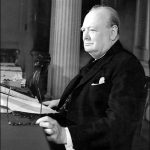 and Japanese attacks. After the outbreak of World War II in Europe, Churchill was called back to his post as First Lord of the Admiralty and eight months later replaced Neville Chamberlain, an ineffective military leader, as prime minister of a new coalition government. In the first year of his administration, Britain stood alone against Nazi Germany, but Churchill promised his country and the world that the British people would “never surrender.” He rallied the British people to a strong resistance and expertly orchestrated Franklin D Roosevelt and Joseph Stalin into an alliance that eventually crushed the Axis. Churchill proved himself to be the best military leader Britain could possibly have had at a time when he was desperately needed. Today would have been Winston Spencer Churchill’s 142nd birthday.
and Japanese attacks. After the outbreak of World War II in Europe, Churchill was called back to his post as First Lord of the Admiralty and eight months later replaced Neville Chamberlain, an ineffective military leader, as prime minister of a new coalition government. In the first year of his administration, Britain stood alone against Nazi Germany, but Churchill promised his country and the world that the British people would “never surrender.” He rallied the British people to a strong resistance and expertly orchestrated Franklin D Roosevelt and Joseph Stalin into an alliance that eventually crushed the Axis. Churchill proved himself to be the best military leader Britain could possibly have had at a time when he was desperately needed. Today would have been Winston Spencer Churchill’s 142nd birthday.

 My niece, Machelle Moore is just six months younger than my daughter, Amy Royce. Their relationship was not always a friendly one, at least not in the early days. In fact, since my daughter, Corrie Petersen was just seventeen months older, than Machelle, the three of them were friends and enemies, but mostly friends…especially as they got older. They were the first three grandchildren on the Schulenberg side, and life changed dramatically for the family. The last little one was their uncle, Ron Schulenberg, and three girls was a whole different thing than one little boy.
My niece, Machelle Moore is just six months younger than my daughter, Amy Royce. Their relationship was not always a friendly one, at least not in the early days. In fact, since my daughter, Corrie Petersen was just seventeen months older, than Machelle, the three of them were friends and enemies, but mostly friends…especially as they got older. They were the first three grandchildren on the Schulenberg side, and life changed dramatically for the family. The last little one was their uncle, Ron Schulenberg, and three girls was a whole different thing than one little boy.
Machelle grew up and went to school to become a cosmetologist, and made the latter years of her  grandparents life a little sweeter, by making trips down to Casper from Powell to visit and cut their hair. Her Grandma Schulenberg still tells me that Machelle is the one who cut her hair to this day, even though she is in a nursing home and they do it there. Thankfully, Alzheimer’s Disease hasn’t stolen that sweet memory of her granddaughter, Machelle cutting her hair and visiting with them for the weekend.
grandparents life a little sweeter, by making trips down to Casper from Powell to visit and cut their hair. Her Grandma Schulenberg still tells me that Machelle is the one who cut her hair to this day, even though she is in a nursing home and they do it there. Thankfully, Alzheimer’s Disease hasn’t stolen that sweet memory of her granddaughter, Machelle cutting her hair and visiting with them for the weekend.
Like everyone else, Machelle’s life is ever changing. Her oldest son, Weston recently got his driver’s license, so that has freed her up in the transportation department. Her younger son, Easton doesn’t need her help much with things either, so that gives Machelle and her husband, Steve time to do what they love best…hunting for Indian artifacts. Machelle’s husband, Steve makes these cool arrowheads and tools, but finding the real ones, left behind by the Indians in the area is very cool too. It’s like walking through the pages 
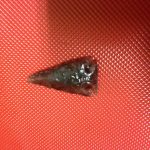 of history in many ways. For Machelle and Steve, that is one of the best ways to relax. It’s funny that so many of us who didn’t care much for history as kids, suddenly find ourselves diving into it with great interest. That’s what I have done, and that is what Machelle and Steve have done. We may like different eras, but in many ways they overlap, and in many ways they are actually the same. I look forward to being able to see more of the artifacts Machelle and Steve have found, as well as the things he makes. Today is Machelle’s birthday. Happy birthday Machelle!! Have a great day!! We love you!!
of history in many ways. For Machelle and Steve, that is one of the best ways to relax. It’s funny that so many of us who didn’t care much for history as kids, suddenly find ourselves diving into it with great interest. That’s what I have done, and that is what Machelle and Steve have done. We may like different eras, but in many ways they overlap, and in many ways they are actually the same. I look forward to being able to see more of the artifacts Machelle and Steve have found, as well as the things he makes. Today is Machelle’s birthday. Happy birthday Machelle!! Have a great day!! We love you!!
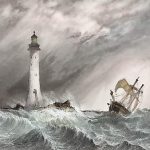
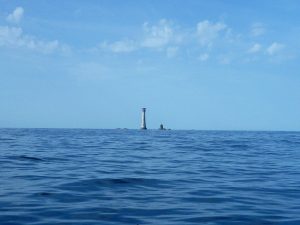 As lighthouses go, Eddystone lighthouse is really quite different than most. The first Eddystone lighthouse was completed in 1699, and was the world’s first open ocean lighthouse, although the Cordouan lighthouse preceded it as the first offshore lighthouse. The Eddystone Lighthouse is on the dangerous Eddystone Rocks, 9 statute miles south of Rame Head, England, United Kingdom. While Rame Head is in Cornwall, the rocks are in Devon. Putting a lighthouse in the open ocean was a rather dangerous undertaking, but it was also an important lighthouse, because of the rocks it sat on. Without a lighthouse there, ships would run aground on the rocks.
As lighthouses go, Eddystone lighthouse is really quite different than most. The first Eddystone lighthouse was completed in 1699, and was the world’s first open ocean lighthouse, although the Cordouan lighthouse preceded it as the first offshore lighthouse. The Eddystone Lighthouse is on the dangerous Eddystone Rocks, 9 statute miles south of Rame Head, England, United Kingdom. While Rame Head is in Cornwall, the rocks are in Devon. Putting a lighthouse in the open ocean was a rather dangerous undertaking, but it was also an important lighthouse, because of the rocks it sat on. Without a lighthouse there, ships would run aground on the rocks.
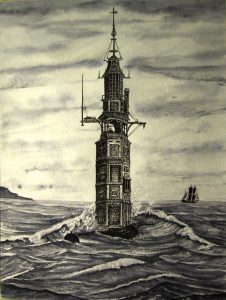
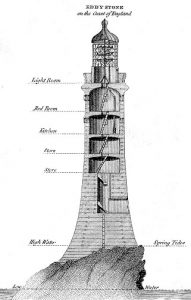
The Eddystone lighthouse fell to disaster three times, and was rebuilt threes times. The first disaster came just four years later, when the Great Storm of 1703 took with it, the first Eddystone lighthouse. The first and second lighthouses were constructed of wood. This was the material available at the time. It was also the wooden construction that made the lighthouse susceptible to the distructive storm and the fire that destroyed the first and second lighthouses…the storm in 1703 and the fire in 1755. The third lighthouse is often called Smeaton’s lighthouse. It was recommended by the Royal Society, civil engineer John Smeaton and was modeled in the shape on an oak tree, and built of granite blocks. He pioneered hydraulic lime, a concrete that cured under water, and developed a technique of securing the granite blocks using dovetail joints and marble dowels. Construction started in 1756 at Millbay and the light was first lit on October 16, 1759. It was state of the art in 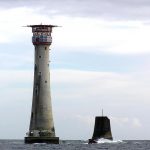
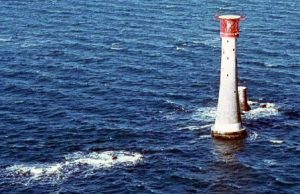 its time. It stood until 1877, when the rocks eroded enough to cause the lighthouse to rock from side to side in the waves, so it was deemed unsafe. The fourth and current lighthouse was built in April of 1879, and was designed by James Douglass, using Robert Stevenson’s developments of Smeaton’s techniques. By April 1879 the new site, on the South Rock was being prepared during the 3½ hours between ebb and flood tide. This current lighthouse is shorter and has a flat top, that is used to land helicopters.
its time. It stood until 1877, when the rocks eroded enough to cause the lighthouse to rock from side to side in the waves, so it was deemed unsafe. The fourth and current lighthouse was built in April of 1879, and was designed by James Douglass, using Robert Stevenson’s developments of Smeaton’s techniques. By April 1879 the new site, on the South Rock was being prepared during the 3½ hours between ebb and flood tide. This current lighthouse is shorter and has a flat top, that is used to land helicopters.

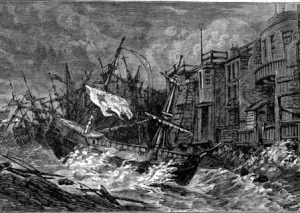 Back in the 1700s, there were no early warning systems for storms, and I suppose it wouldn’t matter anyway, at least not when it came to the Great Storm of 1703. The storm was a destructive extratropical cyclone that struck central and southern England on November 26, 1703, which would actually have been December 7, by today’s calendar. You see the dates all changed with the adoption of the Gregorian calendar, which was originally developed in 1582, but not adopted by England until 1752. The storm brought with it high winds topping 80 miles per hour, which may not seem so extreme on dry land, but over water, it’s devastating. In fact, the wind was so bad, that it actually blew 2,000 chimney stacks over in London. It also blew over 4,000 oak trees down in New Forest. The winds blew ships hundreds of miles off course, and over 1,000 seamen lost their lives on the Goodwin Sands alone.
Back in the 1700s, there were no early warning systems for storms, and I suppose it wouldn’t matter anyway, at least not when it came to the Great Storm of 1703. The storm was a destructive extratropical cyclone that struck central and southern England on November 26, 1703, which would actually have been December 7, by today’s calendar. You see the dates all changed with the adoption of the Gregorian calendar, which was originally developed in 1582, but not adopted by England until 1752. The storm brought with it high winds topping 80 miles per hour, which may not seem so extreme on dry land, but over water, it’s devastating. In fact, the wind was so bad, that it actually blew 2,000 chimney stacks over in London. It also blew over 4,000 oak trees down in New Forest. The winds blew ships hundreds of miles off course, and over 1,000 seamen lost their lives on the Goodwin Sands alone.
London suffered extensive damage. The lead roofing was blown off Westminster Abbey and Queen Anne had to seek shelter in a cellar at Saint James’s Palace to avoid collapsing chimneys and part of the roof. About 700 ships were heaped together in the Pool of London, which is the section of the Thames River downstream from the London Bridge. The ship HMS Vanguard was wrecked at Chatham. Admiral Sir Cloudesley Shovell’s HMS Association was blown from Harwich to Gothenburg in Sweden before it could make its way back to England. Pinnacles were blown from the top of King’s College Chapel, in Cambridge. At sea, many ships were wrecked, some of which were returning from helping Archduke Charles, the claimed King of Spain, fight the French in the War of the Spanish Succession. These ships included HMS Stirling Castle, HMS Northumberland, HMS Mary and HMS Restoration, with about 1,500 seamen killed particularly on the Goodwin Sands. Between 8,000 and 15,000 lives were lost overall.
The Church of England declared that the vicious storm was God’s vengeance for the sins of the nation. Maybe this is where the 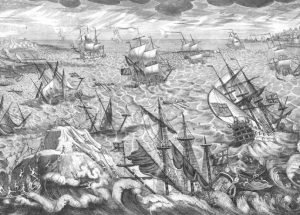
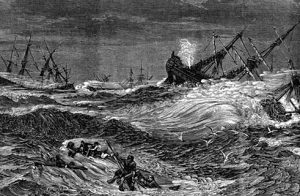 rediculous saying, “act of God” was coined. In fact, Daniel Defoe thought it was a divine punishment for poor performance against Catholic armies in the War of the Spanish Succession. That makes the whole statement even more ridiculous. I suppose people have to explain away these wild occurrences somehow, and since they didn’t have the science to explain the storm, they blamed God for it.
rediculous saying, “act of God” was coined. In fact, Daniel Defoe thought it was a divine punishment for poor performance against Catholic armies in the War of the Spanish Succession. That makes the whole statement even more ridiculous. I suppose people have to explain away these wild occurrences somehow, and since they didn’t have the science to explain the storm, they blamed God for it.
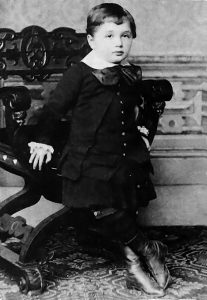
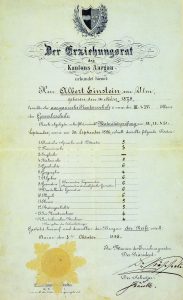 Of the great minds that have lived, I think I like Albert Einstein the best. I suppose some people would disagree with me, but each person relates differently to people, than other people do. I wish I could have met Einstein, because I think we think a lot alike. Of course, I don’t claim to have anywhere near the level of IQ that he had, but I do see some similarities in how we think. We both had the tendency to think that if something can be written down, or in my case stored in my iPhone, then I don’t need to store it in my mind too.
Of the great minds that have lived, I think I like Albert Einstein the best. I suppose some people would disagree with me, but each person relates differently to people, than other people do. I wish I could have met Einstein, because I think we think a lot alike. Of course, I don’t claim to have anywhere near the level of IQ that he had, but I do see some similarities in how we think. We both had the tendency to think that if something can be written down, or in my case stored in my iPhone, then I don’t need to store it in my mind too.
For Einstein, who was a genius, not storing information in his head became a bit of a problem once, when he misplaced the train ticket he had just purchased. When the conductor came by to take his ticket, a frantic Einstein searched unsuccessfully for his ticket. Seeing that he was obviously very upset by this occurrence, the conductor told him, “It’s alright, Mr Einstein, I saw you buy your ticket.” Einstein, still highly upset, said, “It may be alright with you, but if I don’t find my ticket, I don’t know where to get off!” That must have shocked the conductor, because he knew that Albert Einstein rode the same train to and from work every day. Of course, many things are different these days, and I don’t ride a train, plus I’m quite good at navigation, so I don’t see myself not knowing where to get off or to turn, in my case, but it was a real problem to Albert Einstein. It was also an incident that I found amusing, given the mind this man had. Einstein is said to have had an IQ of between 160 and 190, and while I have not been tested, I am quite sure that my IQ is not as high as Einstein’s was, by any stretch of the imagination.
I do know that Einstein had the ability to understand things that would boggle the minds of most people. “Einstein showed that absolute time had to be replaced by a new absolute: the speed of light. Einstein went against the grain and totally dismissed the “Old Physics.” He envisioned a world where space and time are 
 relative and the speed of light is absolute. Prior to that time, it was believed that space and time were absolute and the speed of light was relative. In 1921, Albert Einstein was awarded the Nobel Prize in Physics “for his services to theoretical physics and especially for his discovery of the law of the photoelectric effect”. In 1925, he was awarded the Copley Medal by the Royal Society, which is perhaps the oldest surviving scientific award in the world. Einstein’s mind was so interesting to me, but to him, it was just normal.
relative and the speed of light is absolute. Prior to that time, it was believed that space and time were absolute and the speed of light was relative. In 1921, Albert Einstein was awarded the Nobel Prize in Physics “for his services to theoretical physics and especially for his discovery of the law of the photoelectric effect”. In 1925, he was awarded the Copley Medal by the Royal Society, which is perhaps the oldest surviving scientific award in the world. Einstein’s mind was so interesting to me, but to him, it was just normal.

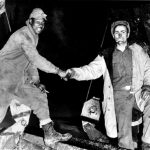 For as long as I can remember, the Alaskan Highway, known as the ALCAN Highway, has been something my parents, and especially my dad had been interested in…for most of his adult life, in fact. Construction began on the highway during World War II for the purpose of connecting the contiguous United States to Alaska through Canada. The highway begins in Dawson Creek, British Columbia, at the junction of several Canadian highways, and runs to Delta Junction, Alaska, via Whitehorse, Yukon. The highway was completed in 1942 at a length of 1,700 miles, but as of 2012, it is only 1,387 miles long. The difference is due to constant reconstruction of the highway, which has included rerouting and straightening numerous sections. The highway formally opened on November 21, 1942, but only for military use. It was not opened to the public until 1948. The highway has been legendary for decades as being a rough and challenging drive, probably because parts of it were not paved. Now however, the entire length is paved, so I suppose that took much of the difficulty out of it.
For as long as I can remember, the Alaskan Highway, known as the ALCAN Highway, has been something my parents, and especially my dad had been interested in…for most of his adult life, in fact. Construction began on the highway during World War II for the purpose of connecting the contiguous United States to Alaska through Canada. The highway begins in Dawson Creek, British Columbia, at the junction of several Canadian highways, and runs to Delta Junction, Alaska, via Whitehorse, Yukon. The highway was completed in 1942 at a length of 1,700 miles, but as of 2012, it is only 1,387 miles long. The difference is due to constant reconstruction of the highway, which has included rerouting and straightening numerous sections. The highway formally opened on November 21, 1942, but only for military use. It was not opened to the public until 1948. The highway has been legendary for decades as being a rough and challenging drive, probably because parts of it were not paved. Now however, the entire length is paved, so I suppose that took much of the difficulty out of it.
My dad has always loved to travel, and the ALCAN Highway literally called his name. It was his dream for all of his daughters and their families to caravan to Alaska by way of the ALCAN Highway. I think that needed to be a trip taken when we were all still single, and living at home, because it ended up being an unrealized dream 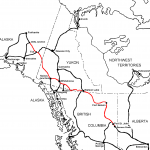
 from my dad’s life. I think Dad would have made the trip anytime we could all get our plans together, but that simply never happened. If one of us could have done it, some of the others couldn’t have, and Dad couldn’t fathom the idea of leaving anyone out. When their 50th wedding anniversary rolled around in 2003, my sisters and I decided that we needed to send them on an Alaska cruise, and while it was not the drive on the ALCAN Highway that Dad had wanted, it did let them visit Alaska, and that was the main thing…I suppose. They had a wonderful time, but I’m sure that it was a little bittersweet too, because they were there without their family. My husband, Bob and I, and my niece Toni Chase and her husband, Dave have since taken cruises to Alaska too, and I know my parents would be happy about that, but looking back now, I wish we could have figured out a way to make their dream of the drive on the ALCAN Highway a reality. I really do continue to regret that.
from my dad’s life. I think Dad would have made the trip anytime we could all get our plans together, but that simply never happened. If one of us could have done it, some of the others couldn’t have, and Dad couldn’t fathom the idea of leaving anyone out. When their 50th wedding anniversary rolled around in 2003, my sisters and I decided that we needed to send them on an Alaska cruise, and while it was not the drive on the ALCAN Highway that Dad had wanted, it did let them visit Alaska, and that was the main thing…I suppose. They had a wonderful time, but I’m sure that it was a little bittersweet too, because they were there without their family. My husband, Bob and I, and my niece Toni Chase and her husband, Dave have since taken cruises to Alaska too, and I know my parents would be happy about that, but looking back now, I wish we could have figured out a way to make their dream of the drive on the ALCAN Highway a reality. I really do continue to regret that.
Over the years, informal historic mileposts have been added to denote major stopping points in the highway’s construction. Dawson Creek sports the milepost marker for the start of the ALCAN Highway. Delta Junction, which is the end of the highway, makes reference to its location at Historic Milepost 1422. The Alaska Highway meets the Richardson Highway at this point. The Richardson Highway continues 96 miles to the city of 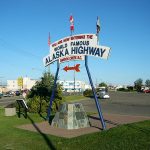
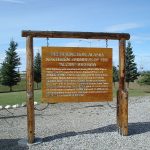 Fairbanks. This is often regarded, though unofficially, as the northern portion of the Alaska Highway, with Fairbanks at Historic Milepost 1520. It makes sense, but was not part of the original construction. The mileposts on this stretch of highway are measured from Valdez, rather than the Alaska Highway. Another oddity is that, the ALCAN Highway is popularly, though not officially, considered part of the Pan-American Highway, which extends south to Argentina, despite its discontinuity in Panama. It’s quite an amazing system, and I think I can see why my dad was so fascinated by it.
Fairbanks. This is often regarded, though unofficially, as the northern portion of the Alaska Highway, with Fairbanks at Historic Milepost 1520. It makes sense, but was not part of the original construction. The mileposts on this stretch of highway are measured from Valdez, rather than the Alaska Highway. Another oddity is that, the ALCAN Highway is popularly, though not officially, considered part of the Pan-American Highway, which extends south to Argentina, despite its discontinuity in Panama. It’s quite an amazing system, and I think I can see why my dad was so fascinated by it.
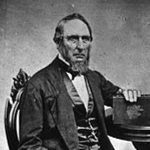
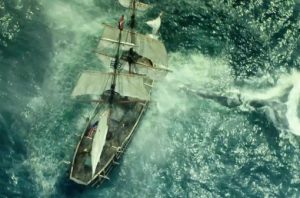 I’m sure most of us have read “Moby Dick” at some point in our school years. For those who haven’t, it was the story of a whale, and while I didn’t know this before, the book was actually based on a true story. The book, written by Herman Melville, was first published in 1851. Melville had heard about the incident involving a whaling ship that had been attacked by a sperm whale…a giant 85 foot sperm whale, a few years earlier, and like most writers, there are just some things that you can’t get out of your head. Those are the stories that you know that you must write. Melville’s research gave him the facts of the incident, but it didn’t take him full circle to actually being in the place where that ship had started it fateful journey…Nantucket. Melville knew that someday he would have to make the trip to the Massachusetts island, where Captain George Pollard Jr lived. Pollard was the man Melville had modeled his fictional Captain Ahab after.
I’m sure most of us have read “Moby Dick” at some point in our school years. For those who haven’t, it was the story of a whale, and while I didn’t know this before, the book was actually based on a true story. The book, written by Herman Melville, was first published in 1851. Melville had heard about the incident involving a whaling ship that had been attacked by a sperm whale…a giant 85 foot sperm whale, a few years earlier, and like most writers, there are just some things that you can’t get out of your head. Those are the stories that you know that you must write. Melville’s research gave him the facts of the incident, but it didn’t take him full circle to actually being in the place where that ship had started it fateful journey…Nantucket. Melville knew that someday he would have to make the trip to the Massachusetts island, where Captain George Pollard Jr lived. Pollard was the man Melville had modeled his fictional Captain Ahab after.
On his last day in Nantucket, Melville met George Pollard Jr, who was the captain of the Essex. He was an old man of 60 years, and in reality, probably didn’t resemble the captain of the Essex much at that point. He had been through so much. As they talked, Pollard told Melville’s fictional story from a far too real perspective…being there. Pollard was just 29 years old when he and his crew set out for a voyage that was to have lasted two and a half years. After the sinking of the Essex, Pollard told the full story to fellow captains over a dinner shortly after his rescue from the ordeal, and to a missionary named George Bennet. Bennet thought the tale was almost a confession. He told them of “92 days and sleepless nights at sea in a leaking boat with no food, his surviving crew going mad beneath the unforgiving sun, eventual cannibalism and the harrowing fate of two teenage boys, including Pollard’s first cousin, Owen Coffin.” Then he said, “But I can tell you no more…my head is on fire at the recollection. I hardly know what I say.”
Just two days after leaving Nantucket, Essex’s ordeal began. It was August 14, 1819. They hit a squall that destroyed it’s topgallant sail, almost causing it to sink. Still, Pollard continued on, making it to Cape Horn five weeks later. But the 20-man crew found the waters off South America nearly fished out, so they decided to sail for distant whaling grounds in the South Pacific, far from any shores. By November of 1820, after months of a prosperous voyage and a thousand miles from the nearest land, whaleboats from the Essex had harpooned whales that dragged them out toward the horizon in what the crew called “Nantucket sleigh rides.” Owen Chase, the 23 year old first mate, had stayed aboard the Essex to make repairs while Pollard went whaling. It was Chase who spotted a very big whale…85 feet in length, he estimated…lying quietly in the distance, its head facing the ship. Then, after two or three spouts, the giant whale headed straight for the Essex, “coming down for us at great celerity,” Chase would recall, “at about three knots. The whale smashed head-on into the ship with such an appalling and tremendous jar, as nearly threw us all on our faces.”
The whale passed underneath the ship and began thrashing in the water. “I could distinctly see him smite his jaws together, as if distracted with rage and fury,” Chase recalled. Then the whale disappeared. The crew was addressing the hole in the ship and getting the pumps working when one man cried out, “Here he is…he is making for us again.” Chase spotted the whale, his head half out of water, bearing down at great speed…this time at six knots, Chase thought. This time it hit the bow directly under the cathead and disappeared for good, but the damage was done. The water rushed into the ship so fast, the only thing the crew could do was lower the boats and try to fill them with navigational instruments, bread, water and supplies before the Essex turned over on its side. Pollard saw his ship listing from a distance, tand returned to see the Essex in ruin. In shock, 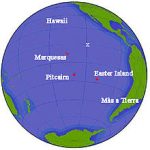
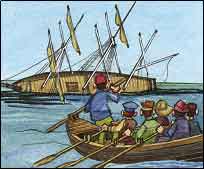 he asked the first mate what had happened. I’m sure the tale seemed incredulous, but the evidence was right there staring them in the face. When the other boats returned, the men sat in silence, their captain still pale and speechless. Some, Chase observed, “had no idea of the extent of their deplorable situation.” Out of the original 20 men and 3 boats that set out, only 5 men would survive the ordeal, and that included a long time floating around the ocean, men dying, and the eventual cannibalism required to survive.
he asked the first mate what had happened. I’m sure the tale seemed incredulous, but the evidence was right there staring them in the face. When the other boats returned, the men sat in silence, their captain still pale and speechless. Some, Chase observed, “had no idea of the extent of their deplorable situation.” Out of the original 20 men and 3 boats that set out, only 5 men would survive the ordeal, and that included a long time floating around the ocean, men dying, and the eventual cannibalism required to survive.

